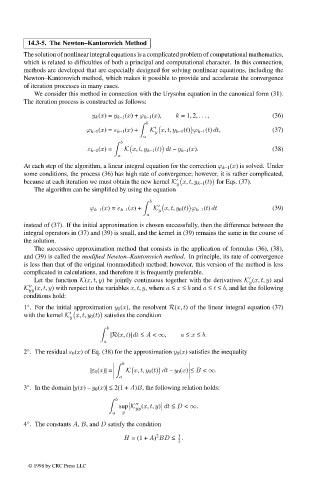Page 690 - Handbook Of Integral Equations
P. 690
14.3-5. The Newton–Kantorovich Method
The solution of nonlinear integral equations is a complicated problem of computational mathematics,
which is related to difficulties of both a principal and computational character. In this connection,
methods are developed that are especially designed for solving nonlinear equations, including the
Newton–Kantorovich method, which makes it possible to provide and accelerate the convergence
of iteration processes in many cases.
We consider this method in connection with the Urysohn equation in the canonical form (31).
The iteration process is constructed as follows:
y k (x)= y k–1 (x)+ ϕ k–1 (x), k =1, 2, ... , (36)
b
ϕ k–1 (x)= ε k–1 (x)+ K x, t, y k–1 (t) ϕ k–1 (t) dt, (37)
y
a
b
ε k–1 (x)= K x, t, y k–1 (t) dt – y k–1 (x). (38)
a
At each step of the algorithm, a linear integral equation for the correction ϕ k–1 (x) is solved. Under
some conditions, the process (36) has high rate of convergence; however, it is rather complicated,
because at each iteration we must obtain the new kernel K x, t, y k–1 (t) for Eqs. (37).
y
The algorithm can be simplified by using the equation
b
ϕ k–1 (x)= ε k–1 (x)+ K x, t, y 0 (t) ϕ k–1 (t) dt (39)
y
a
instead of (37). If the initial approximation is chosen successfully, then the difference between the
integral operators in (37) and (39) is small, and the kernel in (39) remains the same in the course of
the solution.
The successive approximation method that consists in the application of formulas (36), (38),
and (39) is called the modified Newton–Kantorovich method. In principle, its rate of convergence
is less than that of the original (nonmodified) method; however, this version of the method is less
complicated in calculations, and therefore it is frequently preferable.
Let the function K(x, t, y) be jointly continuous together with the derivatives K (x, t, y) and
y
K (x, t, y) with respect to the variables x, t, y, where a ≤ x ≤ b and a ≤ t ≤ b, and let the following
yy
conditions hold:
1 . For the initial approximation y 0 (x), the resolvent R(x, t) of the linear integral equation (37)
◦
with the kernel K x, t, y 0 (t) satisfies the condition
y
b
|R(x, t)| dt ≤ A < ∞, a ≤ x ≤ b.
a
2 . The residual ε 0 (x) of Eq. (38) for the approximation y 0 (x) satisfies the inequality
◦
b
|ε 0 (x)| = K x, t, y 0 (t) dt – y 0 (x) ≤ B < ∞.
a
3 . In the domain |y(x) – y 0 (x)|≤ 2(1 + A)B, the following relation holds:
◦
b
sup K (x, t, y) dt ≤ D < ∞.
yy
a y
4 . The constants A, B, and D satisfy the condition
◦
2
1
H =(1 + A) BD ≤ .
2
© 1998 by CRC Press LLC
© 1998 by CRC Press LLC
Page 673

